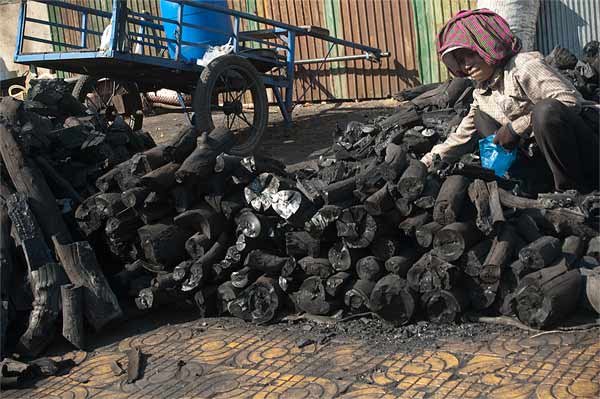អុស និងធ្យូង គឺជាប្រភពថាមពលចម្បង សម្រាប់ទាំងលក្ខណៈគ្រួសារ និងលក្ខណៈសហគ្រាសខ្នាតតូច និងមធ្យមជាច្រើន (SME) ដូចជា ឧស្សាហកម្មឡឥដ្ឋ និងក្បឿង ជាដើម។
ស្ត្រីម្នាក់កំពុងរើសធ្យូងនៅភ្នំពេញ។ រូបភាព ថតដោយ Kelly Irving, ២៥ កុម្ភះ ២០១០។ ក្រោមអាជ្ញាប័ណ្ណ CC BY-ND 2.0។
លទ្ធផលជំរឿនឆ្នាំ ២០០៨ បានបង្ហាញថា គ្រួសារកម្ពុជា ៩១ ភាគរយ ប្រើប្រាស់ជីវៈម៉ាស់ជាថាមពលចម្បង សម្រាប់ចម្អិនអាហារដែលក្នុងនោះផងដែរ ការប្រើប្រាស់អុសមាន ៨៤ ភាគរយ និង ការប្រើប្រាស់ធ្យូងមាន ៧ ភាគរយ។1
ប្រទេសកម្ពុជា នៅតែផ្នែកយ៉ាងខ្លាំងទៅលើការប្រើប្រាស់អុស ជាពិសេសនៅតាមតំបន់ជនបទ ដែលប្រើប្រាស់អុសជាថាមពលសម្រាប់ចម្អិនអាហារ ៩៤ ភាគរយ ហើយតម្រូវការនេះ នៅតែបន្តកើនឡើង ដោយសារតែកំណើនប្រជាជន។ ចំណែកឯ ការប្រើប្រាស់ធ្យូងនៅតាមតំបន់ជនបទវិញ នៅមានចំនួនតិចនៅឡើយ បើប្រៀបធៀបជាមួយនឹងការប្រើប្រាស់អុស។
យោងតាមការធ្វើជំរឿនថ្នាក់ជាតិចុងក្រោយនេះ ការប្រើប្រាស់ធ្យូងនៅតាមតំបន់ទីប្រជុំជន បានកើនឡើងដល់ ២៦ ភាគរយ ខណៈដែលការប្រើប្រាស់អុស មានចំនួន ៣៥ ភាគរយ នៃថាមពលសម្រាប់ចម្អិនអាហារ ដែលត្រូវបានប្រើប្រាស់។2
ហ្កាស
ហ្កាស (LPG) គឺជាល្បាយឧស្ម័នអ៊ីដ្រូកាបូនឆេះ ដែលជាទូទៅ វត្រូវបានប្រើប្រាស់ជាថាមពលលក្ខណៈគ្រួសារ ឧស្សាហកម្ម ពាណិជ្ជកម្ម កសិកម្ម និងសិប្បកម្ម ជាដើម។
នៅកម្ពុជា ហ្កាសត្រូវបានប្រើប្រាស់ជាថាមពលចម្អិនអាហារចម្បង មានចំនួនគ្រួសារ ៧.៩ ភាគរយ យោងតាមការធ្វើជំរឿនថ្នាក់ជាតិឆ្នាំ២០០៨។3
ខណៈពេលដែលសេដ្ឋកិច្ចរបស់ប្រទេសកម្ពុជាកំពុងរីកចម្រើន កម្រិតជីវភាពរស់នៅរបស់ប្រជាជនក៏មានការរីកចម្រើនជាបន្តបន្ទាប់ ជាពិសេសប្រជាជននៅរាជធានីភ្នំពេញ។ ការកើនឡើងប្រាក់ចំណូល បានធ្វើឱ្យក្រុមគ្រួសារមួយចំនួន ធ្វើការផ្លាស់ប្តូរពីការប្រើអុសឬធ្យូង មកប្រើប្រាស់ហ្កាស សម្រាប់ការចម្អិនអាហារ។ ហ្កាស ត្រូវបានគេមើលឃើញថា ជាជម្រើសជំនួសដែលល្អ សម្រាប់ថាមពលចម្អិនអាហារ បើទោះជាគ្រួសារនៅតាមតំបន់ជនបទ មិនទាន់មានលទ្ធភាព។
ធ្វើបច្ចុប្បន្នភាព៖ ៣០ កញ្ញា ២០១៥


